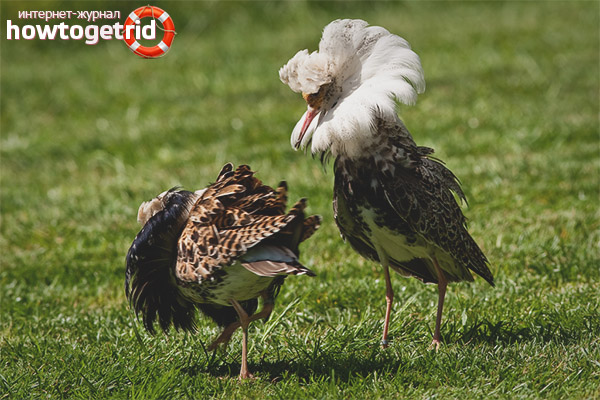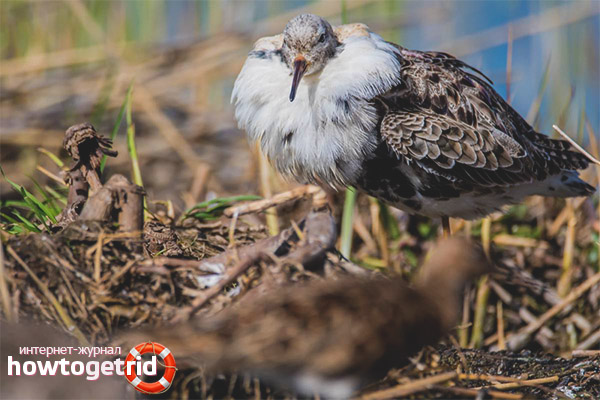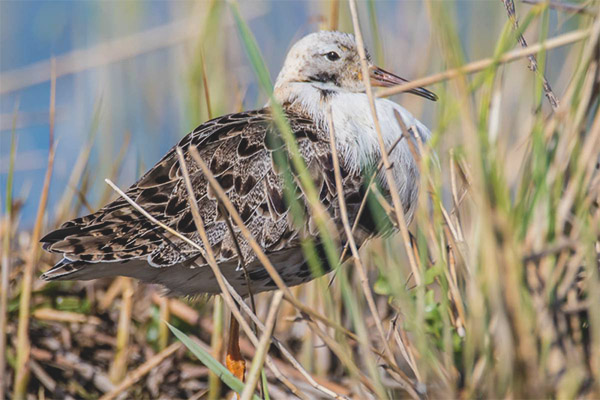The content of the article
Males of bird Turukhtan during the mating period have a very attractive appearance. But they attract females not only with their bright appearance. They perform beautiful dances, conduct battles among themselves, in such a way trying to attract attention and take a certain place in the hierarchy. After all, they have to conquer the female every year, as the species belongs to polygamous.
general description
The length of the male body is about 26-29 cm, while females are on average 5 cm shorter. The mass of the male is about 125-225 g, while females weigh from 75 to 145 g. Puberty in puchtans begins at the age of 1-2 years.
Nesting takes place from May to August. The female lays about 4 eggs at a time. The incubation period lasts about 3 weeks.
Turukhtan belongs to schooling birds, they are active in the daytime, polygamous by nature. Food for them are various mollusks, insects, as well as plant seeds.These birds live about 11 years.
Appearance
The head is small. The beak is short, slightly curved down.
Eggs of these birds have a greenish tint, they are covered with small black and greenish spots.
The female does not change color throughout the year. It is motley, grayish-brown.
Habitat
These birds live in Siberia, as well as in the north of Europe. They spend the winter in Africa, south of the Sahara desert. This area is very far from nesting sites. Therefore, during migration, birds have to travel a long distance. During the flights, they stop to rest near the reservoirs.
Nutrition
Turukhtans usually hunt at night. They walk along the shores of various reservoirs in search of small aquatic animals. With the help of their beak, they are looking for food in the mud, they can also walk in shallow water or swim. During the nesting period, females feed on land. Here they catch various insects. In the remaining months, their diet may also include various plants. Their favorite treats are snail worms, as well as plant seeds.
Flights

Most of the representatives of the species for the winter fly to Africa. Their wintering grounds are located south of the Sahara. In the autumn over the countries of Central Europe, you can see a flock of Turukhtans. Males arrive at the nesting site in March, while females - a month later.When the nesting period ends, the males first fly away. This happens by the end of June. Females with offspring fly away only in a month.
Lifestyle
In the spring, males gather in groups near reservoirs to begin their ritual battles. Each male in tokovische has his own place, he runs on the ground and tramples on the grass. The bird puts its head forward, raises its plumage, flaps its wings. Turukhtans know how to crawl, they cling to the ground with their beak, and then pull up. The token often ends in a fight between males, they begin to peck at each other, as well as claw at claws. But they do not inflict severe injuries on each other.
The males are in strict time during their toking. Young individuals are at the edge of the tokovischa. Older individuals are located closer to its center. A young male can take a place closer to the center only after winning a duel in a more adult male.
Breeding
As mentioned above, these birds are polygamous. Males, which occupy a more advantageous place in the hierarchy, are able to mate with several females in one mating season.Females fly from one tokishcha to another to find the right partner for themselves. When a partner is selected, the female begins to pull at the collar of the male. After mating, it flies away immediately. This ends their communication.
After that, she builds a nest, incubates eggs, and also takes care of the offspring without the participation of the male. This feature is a distinctive feature of the species from other birds that belong to the family of snipe. His other representatives take care of the offspring together.
These birds build their nests in reeds. They are about half a kilometer away from the current. They make a small depression, covering it with grass, algae, well hiding the nest in the undergrowth. Eggs the female of turukhtana lays in the second half of May or in the beginning of June. The incubation period lasts about 3 weeks, after which chicks appear. They leave the nest as soon as they hatch. Their down has a protective coloration. The female finds food for them for several days, after which they begin an independent life.
Observations

You can also meet these birds in the northern part of France. This territory is located much more to the south than their usual habitat.Previously, they nested in Ukraine. In mid-March, they fly to the territory of the Crimea to their nesting sites. They return to Estonia only at the end of April. During the flights, the birds stop to rest, choosing meadows or plains, near which there are reservoirs. Marshlands are their favorite place. By the migration period, the male loses its marital plumage. During the flight of these birds can be found also in Russia.
Interesting Facts
- These birds are great overcome great distances. Individuals nesting on the territory of Siberia fly every year up to a distance of 15,000 km to get to the wintering place.
- For several decades, turukhtans do not nest in some regions in which they used to live before. They left the Austrian Lake Neusiedler. In addition, they left Ukraine and Hungary. Today, these birds can be seen only in the southern part of their usual range. Interestingly, as early as the beginning of the last century, Turukhtans completely left the territory of Great Britain. But in the 60s they began to nest there again.
- In English, the name of the females and the name of the males sounds differently. The name of the females is translated as “ruff”.In French, the name of the bird sounds like "a knight is beating."
Protection and security
In recent decades, there has been a significant reduction in the number of turkishtans around the world. This is due to human activity. Habitat habitat is destroyed, swamps are drained. Several hundred individuals today nest in the northern part of Germany.
Video: Turuhtan (Philomachus pugnax)











To send